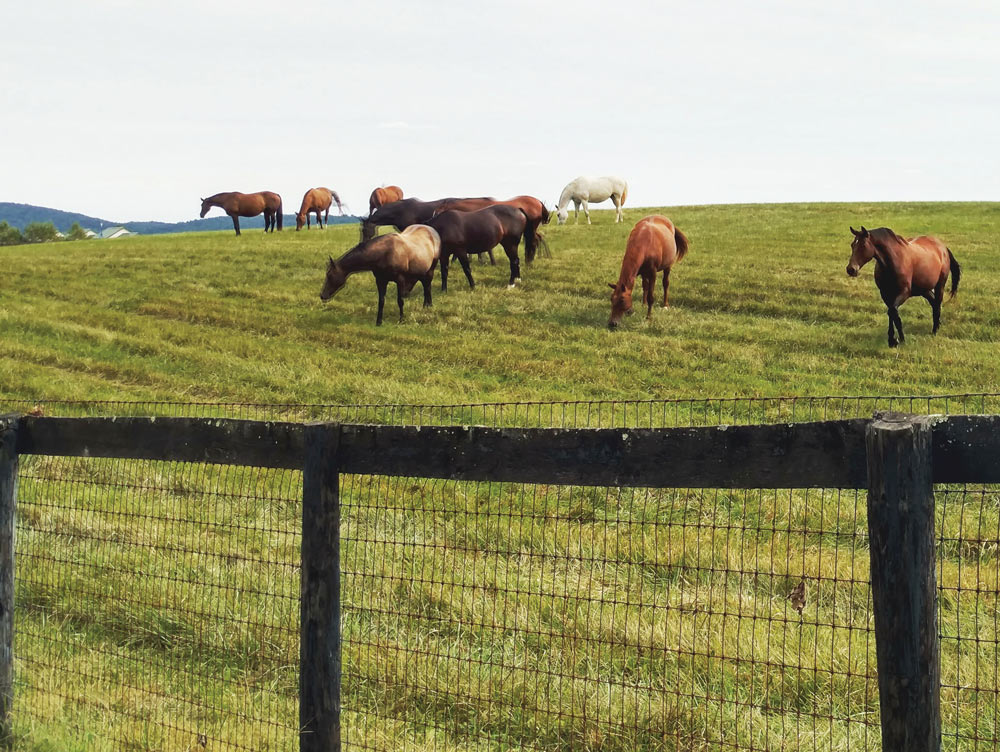Saving lives one pasture at a time

TRF partners with MARE Center on major study
By Bridgett McIntosh and Katie Kaufman
Virginia’s lush green pastures are more than just a picturesque backdrop to horse and hunt country. Researchers at Virginia Tech’s Middleburg Agricultural Research and Extension (MARE) Center are studying the link between the environment, the pasture and the horse to unveil the mysteries behind pasture-associated laminitis, a painful inflammatory condition affecting the tissues that bond the hoof wall to the pedal bone in the horse’s hoof.
The most common yet least understood cause of laminitis is pasture-associated, where horses develop the disease during certain times of the year when environmental conditions favor high levels of nonstructural carbohydrates (NSC), especially sugar, in pasture grasses.
Virginia Tech doctoral student Katie Kaufman is leading the MARE Center’s research efforts aimed at understanding and preventing pasture-associated laminitis through a grazing study examining the changes that occur in a mixed grass pasture and impacts on horse health over one year. Previous research has shown that during certain times of the year, especially in the spring and fall, sugar levels become drastically elevated.
Environmental conditions including duration and intensity of sunlight, air and soil temperature, frost and drought can all affect NSC accumulation in pasture plants. When horses consume diets high in NSC, metabolic and digestive disturbances can occur, leading to the onset of laminitis.
The MARE Center research team features Virginia Tech’s Bridgett McIntosh, master’s student Katie Delano and program coordinator Shayan Ghajar, who are collecting environmental data and tracking changes in the pasture to identify what triggers NSC levels to fluctuate. In turn, the responses of horses grazing the pastures are being examined by measuring blood parameters that indicate alterations in digestion, metabolism and inflammation, as well as by characterizing the hindgut microflora.
Research efforts at the MARE Center are multiplied and made more impactful through collaboration. The Virginia Horse Industry Board, along with several other faculty members from Virginia Tech and other universities, has played an integral part in the project.
However, the Thoroughbred Retirement Foundation (TRF) has played a very special role. An additional healthy Thoroughbred mare was needed to complete the research herd, which includes 12 mares, some with a previous history of laminitis and some that have never had a laminitic episode, and TRF stepped up to the plate.

student Katie Kaufman and Katie Delano, who is pursuing a master’s degree.
Terce was initially rescued from the New Holland sale in 2008 by TRF following a racing career of five starts and only $738 in earnings. When Terce was rescued, she had a severe case of strangles, a bacterial infection that can be life-threatening if not treated properly, and her hooves were in terrible condition. Following great care by TRF staff, Terce made a full recovery and has been a wonderful addition to the MARE Center herd since September.
Through collaboration and community relationships, the MARE Center strives to make a difference through cutting-edge discoveries and outreach for all horses and landowners. With a rich history in pasture-based nutrition research, the center continues to develop new management strategies to benefit horses and the land they graze.
The MARE Center is a 420-acre research and education farm located just outside of Middleburg that was donated to Virginia Tech by philanthropist Paul Mellon in 1949 to serve the community and equine industry by fostering research and education that enhance the health and well-being of horses and the land.
Moving forward with Mellon’s vision, we really can make a difference when we come together to better our community by saving horse’s lives, one pasture at a time. ML
MARE Center
5527 Sullivans Mill Rd., Middleburg, VA 20117
540-687-3521 | arec.vaes.vt.edu/arec/middleburg.html
Thoroughbred Retirement Foundation
10 Lake Ave., Saratoga Springs, NY 12866
518-226-0028 | trfinc.org


